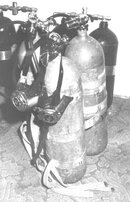I spent a lot of time on these boards lurking through pages of peoples thoughts about Pony Bottles. I selected a 30cf Worthington bottle, with a DIN Atomic Aquatic reg, Dive Rite Travel/Sidemount for sling rigging and a 1" gauge on a 6inch hose.
Done a lot of pool work connecting, disconnecting from my BCD, exchanging regulators, boyancy etc. I was left on my first open water dive when my buddy had low air and the instructors left me alone at 80 feet while helping them. That whole stick with your buddy thing doesn't always happen.
Today the dive shop owner approached me said he saw I had a "stage bottle" an that I don't have the training for it that it's a tech level requirement and they go through hours and hours of how to use it. I said it's a pony bottle and he told me there's no such thing, people just use that phrase as an excuse and that having one causes more problems than it's worth. He doesn't want me wearing them on any training dives with his shop. He said "you don't see anyone else in my shop wearing one?!"
I'm now sitting in the PADI deep diver class where it talks about oh what's this?! Pony Bottles or Alternative Air Source. Thoughts?!
Find another shop. Stage bottles take no real extra effort in the water unless they are bigger then 40cft. You have already practiced the only skill requirement for using a stage as a alternate air and that is switching regs and OOA. As an example, I took a diver with about 30 dives in the water with a 40 cft. no buoyancy issues whats so ever and after about 15 minutes at 20ft doing regulator swapping, OOA drills and handoffs he was so comfortable I had to darn near still my tank back after our diving trip.
---------- Post added September 29th, 2014 at 03:27 PM ----------
He/she ends up in hospital or gets cremated or buried. It's taught in OW class: if you get separated from your dive buddy and can't find him - end the dive. Look for him on the surface. It's taught in OW class to monitor the air supply and surface with 500 PSI. If the student is taking divemaster class then he shouldn't be OOA, period. If we are talking about cases where the student does not follow simple things he/she learned from OW class, then I can come up with gazilion hypothetical situations when the person dies even with a pony: switched to pony and goes OOA, gets entangled, panics, get DCS, rips eardrums, gets air embolism, etc.
Pony is for catastrophic air supply failures. It's not for OOA situations, OOA situations must not ever happen, period. If the diver is not checking the air supply then I can absolutely assume he/she is not checking depth, nitrogen levels, etc. I'd doubt that he'd even remember what embolism is. Which means he has a very high chance of getting injured and killed even with a pony. In this case pony is pointless and it just an annoyance for the rescue and recovery team.
First there is more ways to OOA then a bad dive plan OOA. For example a stuck spg comes to mind. However, beyond OOA you have many reasons to have a pony. For example questionable equipment failure in team diving. A good example of this happened to me while cave diving, I was in the cave and at my first sidemount switch I noticed my spg had developed a leak and partially flooded. Now did the tank breathe? Yes. What is the source of the leak (1st Stage, Hose, spg...)?Hell if I know. From an equipment and training purpose a tank like that is considered not safe and thus should not be relied upon and from a emergency protocol is no different then a empty tank. Of course this scenario also neglects the "Holy F**K, I'm a contender for the darwin award scenario" of emergency resource depletion.
The final option is more towards recreational divers. Most recreational divers have never once considered how much air it takes to actually get two divers up from 130 ft. Using the following as an example:
Diver 1 0.7cft SAC
Diver 2 1.0 cft SAC
120 cft tank at 1100PSI (40CFT appx)
30 fpm ascent
3 minute safety stop required (You dived right up to within a few mins of your liberal dive computers limit like 99% of rec diver out there)
using half pt. atm (figure 30 sec above and 30 sec below)
No panic and OOA occurs with no additional BT penalty
Regulators cutout at 150 PSI
You will use somewhere between 28-31cft just for ascent. That leaves you between 9-12 cft to get your act together at 130 cft. which is about 1-2 minutes (assuming neither of you panic and raise your respiration rate). With a 40 cft bottle slung, even if a diver has a SAC of almost 2.0, they will make it to the top without issue and you still have 40cft to do your ascent.
Daru
P.S. take about 3-4 cft off the used amount for safety stops if you're of the F**K it im going to the top DCS be darned, camp.





